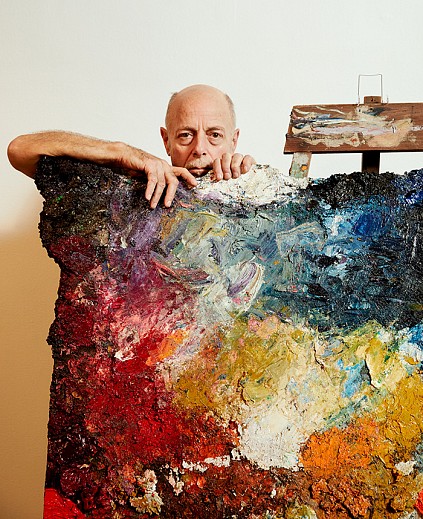
A Kaleidoscopic Unfolding: Bowdoin Magazine
March 16, 2022 - By Wayne Curtis, Photographs By Damon Gardner
“For me, this was all about that guy in the background,” says James Michalopoulos ’74. He’s paused in front of one of his own paintings, hung amid a sprawling and colorful retrospective of his work. The show occupies a large gallery on the second floor of the New Orleans Jazz Museum, which is set in an imposing former US Mint building constructed in the nineteenth century at the edge of the city’s French Quarter.
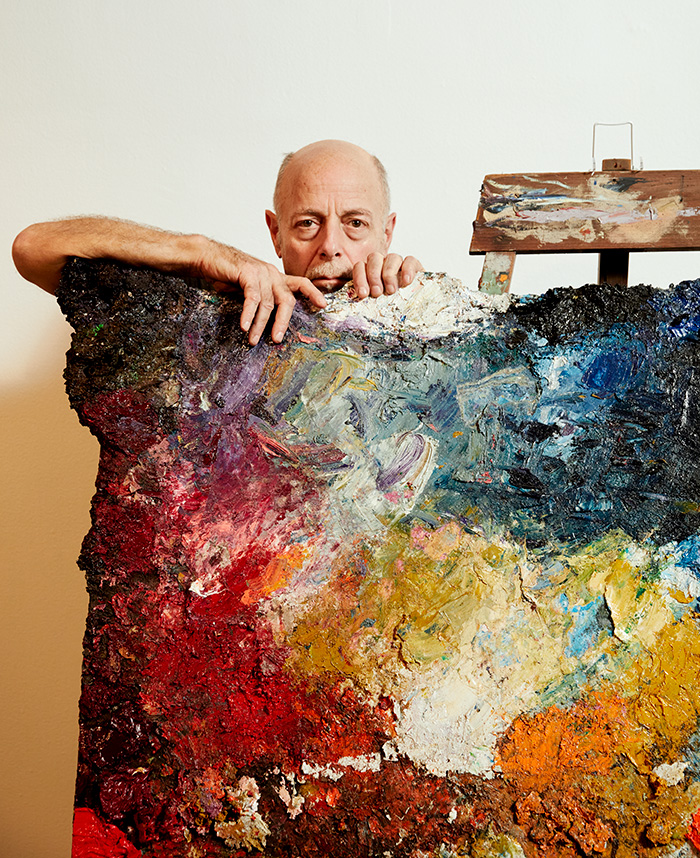
The painting in front of him is uncharacteristically quiet and serene. All around him, his other works depict New Orleans musical royalty, a lineup of larger-than-life luminaries who all but burst of out their frames—Fats Domino, Mahalia Jackson, Louis Armstrong, Allen Toussaint. With his trademark style, which has been described as “rubbery” and “almost psychedelically distorted,” he makes the streets dance and the hidden lives of musicians pulse with energy.
But this one painting is quiet. It depicts three musicians playing their instruments: a sousaphone, a trombone, and a trumpet. They’re in what appears to be a dusky club with a well-varnished wooden floor. They wear the traditional brass band outfits of dark pants, white shirts, black tie, and white marching band caps with peaked crowns.
The trumpet player stands far back, at the edge of shadows, looking downward. “I just made up a story about him,” Michalopoulos says. “He’s in his early forties, and he’s sort of stuck and lost in his life.”
Michalopoulos has for decades been capturing the people, streets, and scenes that animate this city on the Gulf of Mexico. In the four decades that New Orleans has been his home, he’s emerged as the artist arguably most closely associated with it. His paintings are regularly featured at well-attended shows in city museums and galleries; he receives important commissions, both public and private; he has contributed six posters for the city’s high-profile Jazz and Heritage Festival; and he has spawned a raft of imitators who have copied his dynamic, vaguely surrealistic style. His work tends to be frenzied and expressionist, thick ridges of paint atop eskers of more paint. But his vivid tableaux are realistic in another way: they offer a clear lens into the city’s high-spirited life and high-stepping energy.
Yet spend some time with him and you’ll come to understand that it’s not just the people out front leading the nation’s longest and loudest party who capture his attention. He’s equally intrigued by those in the shadows.
“This reminds me of Edward Hopper,” Michalopoulos says, referencing an American artist who had an important influence early in his career. “In his paintings, if you scratched the surface, there’s this yawning despair.”
Michalopoulos is keenly attuned to those on the outskirts of the bright lights, those at risk of being lost amid the music and the dance, especially in a city changing as swiftly and dramatically as New Orleans. The neighborhoods have been gentrifying and are much more expensive. “The class composition has changed, and it’s not as hospitable for artists,” he says. “And I measure everything in that world by that yardstick.”
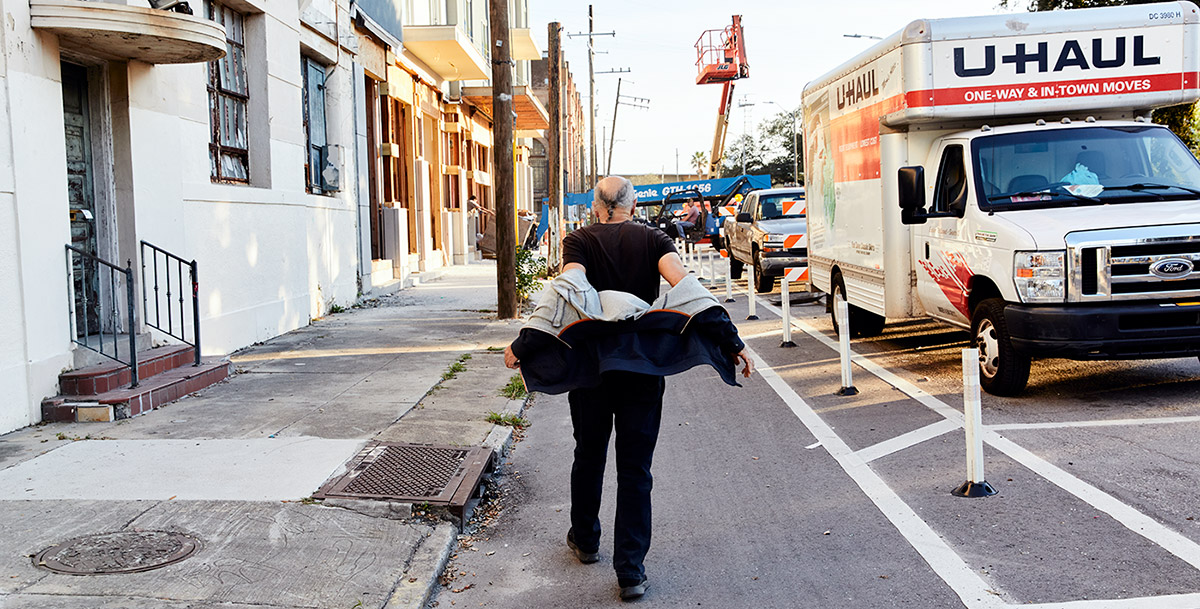
James Michalopoulos was born in Pittsburgh but largely raised in Connecticut, where his family moved when he was seven. His father was a noted architect and urban designer who happened to be an art collector, and Michalopoulos grew up in a household filled with the work of such artists as Braque, Picasso, and his uncle William Baziotes, the abstract expressionist.
Still, art was at the periphery rather than the center of his life. At Bowdoin, new interests steered him toward economics and politics—“You know, that was, like, a tumultuous period socially”—although art lingered at the margins. He recalled a series of paintings of farm animals on exhibition at the Museum of Art by Bowdoin professor Tom Cornell. “It was a series of drawings of pigs, and they were exquisite,” he says. “They were elegant. They were beautiful. And I was just totally taken by it.”
The museum also offered him occasional refuge. This was the early ’70s, and of course he spent a fair amount of time on the Quad, often with Frisbee in hand. The museum was right there, and so he would slip into the quiet of its muffled galleries. “It was a place for me to repair to on occasion,” he says. “It was a good influence, and you know, so much [of life] wasn’t back then.”
He also worked off campus in Brunswick in a food co-op, and took that experience to the Boston area, where he helped launch what would become one of the largest food co-ops in the region, located midway between MIT and Harvard. “We had 4,500 members. I used to cut cheddar cheese for Noam Chomsky,” he says. “Actually, I made that up. But I might have. I hope I did.”
It was on a vacation to Niagara Falls when art caught up with him. It turned out you could only admire the falls for so long, but in wandering around, an intriguing old house caught his attention. He began to sketch it and spent about four days doing so. At one point the owner came out, inquired as to what he was doing, and offered to buy his sketch. He made “about twenty-five dollars.”
He stepped up his sketching and painting after he moved to Washington, DC. On a whim in the winter of 1978, he decided to flee the snow and cold, and he hitchhiked to New Orleans with a backpack and some painting gear. “It was south and warm and exotic—so that was it,” he says.
He arrived at night and walked from the highway where he’d been let off toward the French Quarter, enchanted by the gnarled live oaks that created a canopy over the streets and the vibrant life that spilled off porches and onto the streets. “I was fascinated by all the vitality and the unique richness of it,” he says. He returned to Washington and, the next winter, had a dalliance with Key West. “It was nowhere near as complex or rich as New Orleans.” So the following year he returned once again to the city on the Mississippi River. This time he remained for good.
With his growing artistic success came financial stability, and then some. He acquired several properties. He bought and lived in an old beer warehouse just off Frenchmen Street, using a dozen paintings for a down payment. Inside, he experimented with perspective and materials in full scale, and created a whimsical space of chain link and tin and improbable balconies.
In the more than four decades since he arrived in New Orleans, Michalopoulos has been both influenced by the colorful, confounding streets of the city, and in turn has influenced them.
He began by sketching what he saw on the city’s byways, capturing random scenes and selling his work for a few dollars to get by. Outside a grocery store, he sketched people waiting at a bus stop and hustled to sell them the picture before their bus arrived. He worked for a stint as a courtroom artist for the local paper. He crashed in abandoned houses and lived in a truck for a time.
He sought out a permit to sell at Jackson Square in the heart of the tourist district, but all 200 permits had been issued and he was met with a waiting list. So he moved around, painting and selling here and there, and for a time set up in front of a Bourbon Street restaurant at the invitation of its general manager, pushing a cart with his supplies and clipping his fresh paintings onto a gate for display. He rigged up a Vespa scooter with an easel on the back, a mobile plein air studio and gallery. He painted street scenes he sold to tourists and passersby. When they asked how much the paintings cost, he asked how much money they had.
He is primarily a self-taught painter, although he leveraged his skill by taking two classes on figure drawing at the University of New Orleans and the New Orleans Academy of Fine Art. As his skills improved and his vision sharpened, so did his situation. His work started to sell in places other than on street corners—his first show was at a pizza parlor—and a few galleries asked to feature his work. New Orleans began to take notice.
Along the way, Michalopoulos started to develop a distinct style: a sense of place that captured New Orleans in a way that hadn’t been seen before. In a city that’s long been famed for its unique, idiosyncratic architecture, Michalopoulos added another layer, animating the antiquated houses and spalling buildings. In his renditions, some structures seem at first to be sinking into swampy soils—a not uncommon occurrence around the city, where lintels and cornices often skew at odd angles. But that’s just a springboard to a more ebullient quality, with some buildings seemingly controlled like marionettes enlivened by an outside force, some coming to life on their own in a way that’s both charming and alarming. Upper floors sway one way while bottom floors move another. Perspectives change, violating every canon of classical art.
And then there’s the color—vibrant hues of rich cobalt and crimson, and night skies streaked with indigo and magenta and dotted with luminous crescent moons, all conspiring to create a sense of motion and dance, a vivification of an inanimate world.
He ventured into other businesses, opening a well-regarded restaurant in the nearby town of Covington (since closed). He spent time in France at the encouragement of a patron and eventually bought a home in Burgundy, where he created a studio in an old barn. He also purchased a 700-year-old defunct tile factory along a river, with the idea of making tiles there once again (pending).
“I think there is a quality of movement in most of it,” Michalopoulos wrote in his notes for the show at the Jazz Museum. “I love the lyric that life can be: off-kilter, chaotic, and colorful, a kaleidoscopic unfolding. I try not to interpret too much because I believe it stifles the work.”
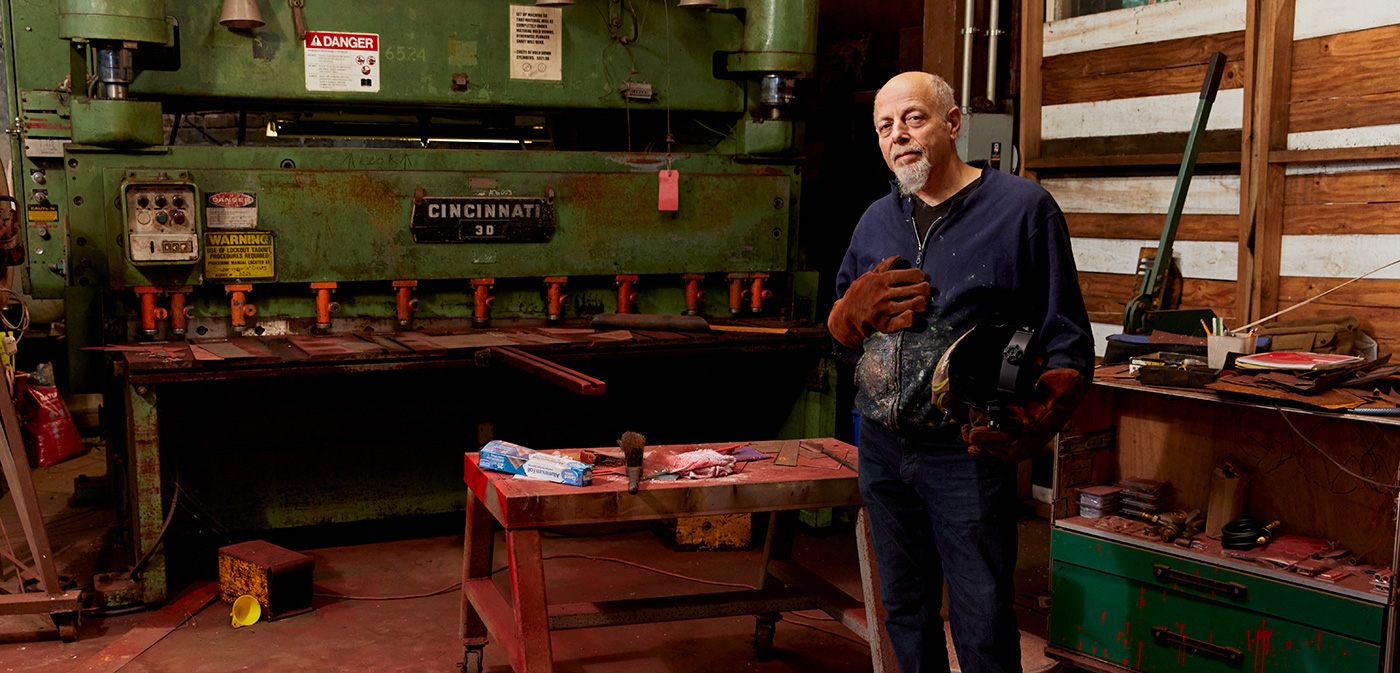
While in France, he came to appreciate the nuances of local wines and wanted to bring that locally grounded approach to adult beverages to New Orleans. The Gulf South is inhospitable to grapes, but sugar cane grows in abundance. He opened a rum distillery in 1995, making it the first craft rum distillery in the nation in over a century. (There are now well over 200 American distilleries making rum.)
In the early 2000s, he acquired a cluster of old buildings on Elysian Fields, where he set up his studio. The main building is sprawling and drafty, with soaring ceilings and ponderous beams and gaps that offer glimpses of the open sky above. In the middle of this interior acreage is an easel and a large, partially completed canvas, surrounded by great piles of empty boxes and spent paint tubes, as high as snow after a plow moves through a street in Maine. Some dusty caskets sit along one side, a reminder that these buildings were once a funeral home. Paintings in various stages of completion lean against the walls here and there.
Even with the demands of keeping track of his expanding businesses, Michalopoulos spends much of his day in this sanctuary, at his easel. Sometimes he listens to music as he paints, sometimes he doesn’t. His multicolored oils are layered on thickly, chiefly with a palette knife. When he picks up a brush, it’s often to use ends opposite the brushes to make ridged stripes and striations in the oils. The paintings have a dense, tactile feel, as if capturing movement unawares.
He’s best known for his architectural paintings, but his eye wanders. He’ll paint musicians for a while, and then “go the other way,” as he puts it, and return to painting houses. “Or sunflowers,” he says. “I couldn’t get away from sunflowers for a whole summer two years ago.” For a time, he went through a cow phase.
With his paintings of musicians, he says he often does several studies—for a portrait of Louis Armstrong, for instance, he says he might do a dozen different versions of his face and expressions in order to get it right. Once he feels he’s getting close, he takes off, with his palette knife moving in rhythmic strokes to fill its broad outlines. When the painting feels right—maybe in a day, maybe in a couple of days—he signs it, marking that it’s ready for the gallery. If not, it remains against a wall, unsigned. He may come back to it the next day, or the next month. Or not at all— abandonment happens, he says.
He shrugs.
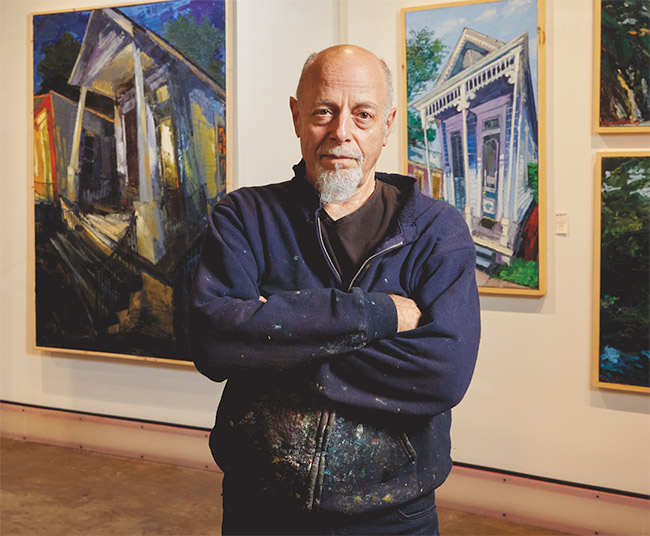
Throughout its three-century history, New Orleans has suffered tremendous peaks and valleys—frequent floods, yellow fever, fires, devastating hurricanes. That’s no less true of the past half century. New Orleans suffered vast population loss as the integration of schools and public facilities caused white families to flee to the suburbs. Widespread destruction followed Hurricane Katrina in 2005. But New Orleans soon rebounded, as empty-nesters and creative-class types were drawn by an urbanity that lies less on a heroic scale and more on the intimacy of the streets, the wanderings of which lead to aromas from a relentless culinary scene and sounds emanating from a vibrant cultural life.
Change implies loss—as one group gains, another loses. That might be the natural evolution of cities, but lately it’s resulted in a rapid gentrification, as one group moves in another is displaced. Michalopoulos is pleased that many of the century-old homes once destined for termites and slow rot are being restored and preserved. But he acknowledges that this comes with unwelcome results—as longtime residents are pushed out of the city, the personality of the city alters. There’s a sense that the old spirit of the city is starting to erode.
“It’s a city where people were encouraged to take risks,” he says. But as rents rise and new residents complain of loud musicians parading through the streets, something becomes lost.
“The base of our culture is celebration,” he says. “Our fundamental engagement in this city is finally religious, even though it looks depraved. It’s a kind of indulgence in service of liberation.”
He notes that Mardi Gras in recent years has become less a joyous celebration of personal creativity and has edged toward a generic, could-be-anywhere party scene. “We treat very casually the wealth that we have,” he says. “And you don’t really appreciate the beauty until it’s not there and it’s all just Bud hats. And you go, ‘What happened?’ It’s a wake-up call.”
When Michalopoulos arrived in the late 1970s, New Orleans was a place where an artist with little means could find a place to land and to grow personally and artistically while just getting by. “The city was always an inexpensive place to live, and it’s turned into an expensive place to live.”
He’s quietly set about doing a small part to reverse that. Among his acquisitions was a compound of old semi-industrial buildings occupying a full city block, with parts dating back to the nineteenth century. It was once home to a beer distributor, whose horses to pull the beer wagons were stabled across the street, and then a paper and box warehouse. “This was a chute for hay,” he says, pointing out a recess in the wall as we walked through one afternoon. “Well, that’s what they say. I think it was probably a chute for paper. Either one, though, it makes sense.”
The 110,000-square-foot complex is in an unlovely but relatively central part of the city, next to a road overpass and a train yard. Michalopoulos and his crew have been gradually converting it into a warren of more than a hundred artists’ studios, which he’s leasing out at reasonable rents. Painters, sculptors, and musicians occupy studios that range from compact to spacious.
“It’s about creating a safe harbor for expression,” he says. “Mostly what we’ve done is artists’ studio space, but we’re looking at a shift into actual housing. We’ll see how we do with it.”
Across the street he’s bought up several ramshackle homes, which he’s in the process of converting into affordable living quarters loosely following a cohousing model, with spaces both private and public for residents. “For me it’s an experiment in a novel idea,” he says. “Here we can live in an environment that will protect us and let us do our thing.”
His new work suggests he is boldly exploring new realms—beyond cottages, sunflowers, and cows. In a large alcove of his studio, next to two very dusty caskets, were his newest canvases, still drying. They were to be patched into one long canvas when installed, extending twenty feet and depicting vast, swirling scenes of
the galaxies and cosmos. Like most everything else that he produces, this painting is the antithesis of static and still. The stars pulse, the galaxies swirl, the cosmic gases seem to quiver with expectation.
The work was commissioned by a health sciences school and was to be installed atop a wide set of stairs. It would create the impression that students are ascending toward the stars. In other hallways, some of his other paintings are hung, including some large semi-abstract canvases inspired by microbes and other microscopic miniatures. “This is a hematological thing,” he noted of one. “At a certain point they become much more like an artistic expression rather than an illustration,” he says.
The space between a pensive horn player lost in thought at a club—a study in incertitude, someone at once the center of and on the margins of that painting featured at the Jazz Museum—to his cosmic new work exemplifies how far Michalopoulos has traveled in his mind, venturing to the far edges of the universe, capturing everything in between in a gyre of unseen motion and swirling colors
Back to Press
